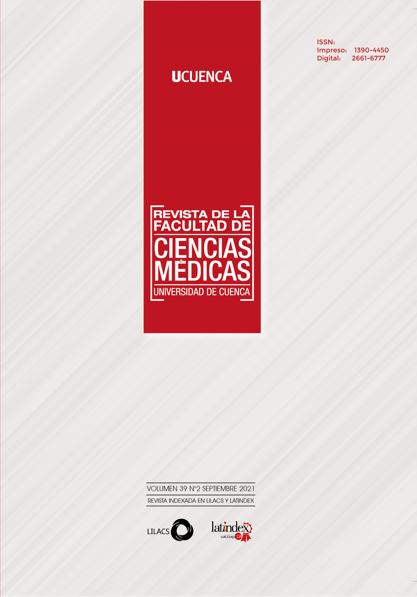Risk factors associated with stages IV and V in diabetic nephropathy at the José Carrasco Arteaga Hospital. Cuenca, 2018-2019
DOI:
https://doi.org/10.18537/RFCM.39.02.05Keywords:
diabetes mellitus type 2, renal disease, kidney diseases, patientsAbstract
Introduction: nephropathy represents one of the main complications of type 2 diabetes mellitus (DM2), being important the determination of the associated risk factors to achieve a timely intervention.
Objective: to determine the risk factors for renal function deterioration in patients with stage IV and V diabetic nephropathy at the José Carrasco Arteaga Hospital, Cuenca 2018-2019.
Methodology: it is an analytical study of cases and controls in the Endocrinology and Nephrology services of the José Carrasco Arteaga Hospital with a sample of 462 patients, with 95% confidence interval, proportion of exposed cases of 23%, proportion of exposed controls of 12 % and minimum power of 80%. The information was processed by generating a database in the SPSS version 15.0 program based on the data collection form to determine the level of association, the Odds Ratio (OR) was used.
Results: the average age was 66.95 ± 11.04 years, with a slight predominance of men (56.5%). The risk factors for diabetic nephropathy (DN) were: secondary hyperparathyroidism (OR=18.69; 95% CI: 11.71-29.84); hyperuricemia (OR=3.04; 95% CI: 1.9-4.85); hyperphosphatemia (OR=6.11; CI95%: 3.31-11.26); hypocalcaemia (OR=1.81; CI95%: 1.13-2.9); poor glycemic control (OR=2.01; 95% CI: 1.38-2.93); obesity (OR=2.01; CI95%: 1.34-2.99); arterial hypertension (OR=6.51; CI95%: 4.21-10.08); smoking (OR=2.34; CI95%: 1.31-4.17), all with p<0.05. Dyslipidemia, non-consumption of statins and ARM were not presented as risk factors for ND.
Conclusions: the development of diabetic nephropathy (DN) was associated with secondary hyperparathyroidism, hyperuricemia, hyperphosphatemia, hypocalcemia, poor glycemic control, obesity, hypertension, and smoking.
Downloads
Published
Issue
Section
License
Copyright (c) 2022 Cristina Maricela Gutama Gutama

This work is licensed under a Creative Commons Attribution-NonCommercial-ShareAlike 4.0 International License.
Copyright © Autors.

You are free to:
 |
Share — copy and redistribute the material in any medium or format |
 |
Adapt — remix, transform, and build upon the material for any purpose, even commercially. |
Under the following conditions:
 |
Attribution — You must give appropriate credit, provide a link to the licence, and indicate if changes were made. You may do so in any reasonable manner, but not in any way that suggests the licenser endorses you or your use. |
| NonCommercial — You may not use the material for commercial purposes. | |
| ShareAlike — If you remix, transform, or build upon the material, you must distribute your contributions under the same license as the original. |
| No additional restrictions — You may not apply legal terms or technological measures that legally restrict others from doing anything the licence permits. |






